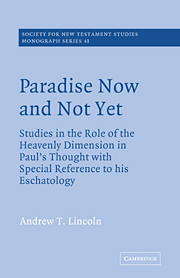 Paradise Now and Not Yet
Paradise Now and Not Yet Book contents
- Frontmatter
- Contents
- Preface
- Abbreviations and note on the text
- Introduction
- 1 Galatians and the heavenly Jerusalem
- 2 1 Corinthians and heavenly existence
- 3 2 Corinthians, the heavenly house and the third heaven
- 4 Philippians and the heavenly commonwealth
- 5 Colossians and heavenly-mindedness
- 6 Ephesians and heavenly life in the Church at worship
- 7 Heaven and the eschatological perspective in Pauline thought
- Notes
- Bibliography
- Index
1 - Galatians and the heavenly Jerusalem
Published online by Cambridge University Press: 03 November 2009
- Frontmatter
- Contents
- Preface
- Abbreviations and note on the text
- Introduction
- 1 Galatians and the heavenly Jerusalem
- 2 1 Corinthians and heavenly existence
- 3 2 Corinthians, the heavenly house and the third heaven
- 4 Philippians and the heavenly commonwealth
- 5 Colossians and heavenly-mindedness
- 6 Ephesians and heavenly life in the Church at worship
- 7 Heaven and the eschatological perspective in Pauline thought
- Notes
- Bibliography
- Index
Summary
Paul's reference to ἡ ἄνω Ἰ∈ρōυσαλήμ in Gal. 4: 26 turns his readers' attention to the heavenly dimension. Elsewhere in the NT the term ἄνω, most characteristic of the Fourth Gospel, is virtually synonymous with heaven and often its purely spatial and its more religious connotations cannot be separated. Here its attributive use is equivalent in meaning to πōυράνιōς.
The polemical setting
In refuting the attacks of the proponents of ‘another gospel’ (1: 6f) who are intent on making capital out of the tensions which existed between the apostle to the Gentiles and the Jerusalem church, Paul in Galatians 1 and 2 sets out the origins of the gospel which he taught and reviews the history of his apostleship as it relates to the ‘pillar apostles’ of the Jerusalem church. In the central section of the letter in chapters 3 and 4 he takes up in a more systematic but nevertheless highly polemical fashion the main issues under debate. He gives his perspective on God's actions in the history of salvation and focuses on the question, ‘Who are the true heirs of Abraham?’ It is to this question that Paul returns in the pericope 4 : 21 – 5: 1 which presents in a novel way the insistence throughout the letter that his is a gospel of grace and freedom. Paul believed this theme to be of vital importance in the Galatian situation where false teachers were attempting to draw away his converts.
- Type
- Chapter
- Information
- Paradise Now and Not YetStudies in the Role of the Heavenly Dimension in Paul's Thought with Special Reference to his Eschatology, pp. 9 - 32Publisher: Cambridge University PressPrint publication year: 1981
- 1
- Cited by


